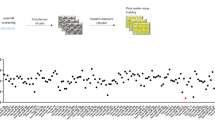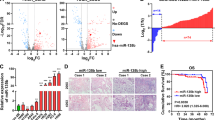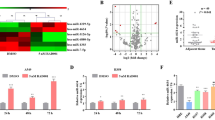Abstract
To define novel pathways that regulate susceptibility to tumor necrosis factor (TNF)-related apoptosis-inducing ligand (TRAIL) in non-small cell lung cancer (NSCLC), we have performed genome-wide expression profiling of microRNAs (miRs). We show that in TRAIL-resistant NSCLC cells, levels of different miRs are increased, and in particular, miR-221 and -222. We demonstrate that these miRs impair TRAIL-dependent apoptosis by inhibiting the expression of key functional proteins. Indeed, transfection with anti-miR-221 and -222 rendered CALU-1-resistant cells sensitive to TRAIL. Conversely, H460-sensitive cells treated with -221 and -222 pre-miRs become resistant to TRAIL. miR-221 and -222 target the 3′-UTR of Kit and p27kip1 mRNAs, but interfere with TRAIL signaling mainly through p27kip1. In conclusion, we show that high expression levels of miR-221 and -222 are needed to maintain the TRAIL-resistant phenotype, thus making these miRs as promising therapeutic targets or diagnostic tool for TRAIL resistance in NSCLC.
This is a preview of subscription content, access via your institution
Access options
Subscribe to this journal
Receive 50 print issues and online access
$259.00 per year
only $5.18 per issue
Buy this article
- Purchase on Springer Link
- Instant access to full article PDF
Prices may be subject to local taxes which are calculated during checkout







Similar content being viewed by others
Change history
04 January 2021
A Correction to this paper has been published: https://doi.org/10.1038/s41388-020-01608-1
28 February 2024
An Editorial Expression of Concern to this paper has been published: https://doi.org/10.1038/s41388-024-02989-3
References
Blain SW, Scher HI, Cordon-Cardo C, Koff A . (2003). p27 as a target for cancer therapeutics. Cancer Cell 3: 111–115.
Brown JM, Attardi LD . (2005). The role of apoptosis in cancer development and treatment response. Nat Rev Cancer 5: 231–237.
Calin GA, Croce CM . (2006). MicroRNA signatures in human cancers. Nat Rev Cancer 6: 857–866.
Calin GA, Dumitru CD, Shimizu M, Bichi R, Zupo S, Noch E et al. (2002). Frequent deletions and down-regulation of micro-RNA genes miR15 and miR16 at 13q14 in chronic lymphocytic leukemia. Proc Natl Acad Sci USA 99: 15524–15529.
Calin GA, Ferracin M, Cimmino A, Di Leva G, Shimizu M, Wojcik SE et al. (2005). A microRNA signature associated with prognosis and progression in chronic lymphocytic leukemia. N Engl J Med 353: 1793–1801.
Chen CZ, Li L, Lodish HF, Bartel DP . (2004). MicroRNAs modulate hematopoietic lineage differentiation. Science 303: 83–86.
Cheng AM, Byrom MW, Shelton J, Ford LP . (2005). Antisense inhibition of human miRNAs and indications for an involvement of miRNA in cell growth and apoptosis. Nucleic Acids Res 33: 1290–1297.
Coqueret O . (2003). New roles for p21 and p27 cell-cycle inhibitors: a function for each cell compartment? Trends Cell Biol 13: 65–70.
Corsten MF, Miranda R, Kasmieh R, Krichevsky AM, Weissleder R, Shah K . (2007). MicroRNA-21 knockdown disrupts glioma growth in vivo and displays synergistic cytotoxicity with neural precursor cell delivered S-TRAIL in human gliomas. Cancer Res 67: 8994–9000.
Craig C, Wersto R, Kim M, Ohri E, Li Z, Katayose D et al. (1997). A recombinant adenovirus expressing p27kip1 induces cell cycle arrest and loss of cyclin-Cdk activity in human breast cancer cells. Oncogene 14: 2283–2289.
Dresios J, Aschrafi A, Owens GC, Vanderklish PW, Edelman GM, Mauro VP . (2005). Cold stress-induced protein Rbm3 binds 60S ribosomal subunits, alters microRNA levels, and enhances global protein synthesis. Proc Natl Acad Sci USA 102: 1865–1870.
Eymin B, Sordet O, Droin N, Munsch B, Haugg M, Van de Craen M et al. (1999). Caspase-induced proteolysis of the cyclin-dependent kinase inhibitor p27kip1 mediates its anti-apoptotic activity. Oncogene 18: 4839–4847.
Falschlehner C, Emmerich CH, Gerlach B, Walczak H . (2007). TRAIL signalling: decisions between life and death. Int J Biochem Cell Biol 39: 1462–1475.
Felli N, Fontana L, Pelosi E, Botta R, Bonci D, Facchiano F et al. (2005). MicroRNAs 221 and 222 inhibit normal erythropoiesis and erythroleukemic cell growth via kit receptor down-modulation. Proc Natl Acad Sci USA 102: 18081–18086.
Fulda S, Meyer E, Debatin KM . (2000). Metabolic inhibitors sensitize for CD95 (APO-1/Fas)-induced apoptosis by down-regulating Fas-associated death domain-like interleukin 1-converting enzyme inhibitory protein expression. Cancer Res 60: 3947–3956.
Galardi S, Mercatelli N, Giorda E, Massalini S, Frajese GV, Ciafrè SA et al. (2007). miR-221 and miR-222 expression affects the proliferation potential of human prostate carcinoma cell lines by targeting p27kip1. J Biol Chem 282: 23716–23724.
Garofalo M, Romano G, Quintavalle C, Romano MF, Chiurazzi F, Zanca C et al. (2007). Selective inhibition of PED protein expression sensitizes B-cell chronic lymphocytic leukaemia cells to TRAIL-induced apoptosis. Int J Cancer 120: 1215–1222.
Ghobrial IM, Witzig TE, Adjei AA . (2005). Targeting apoptosis pathways in cancer therapy. CA Cancer J Clin 55: 178–194.
He H, Jazdzewski K, Li W, Liyanarachchi S, Nagy R, Volinia S et al. (2005). The role of microRNA genes in papillary thyroid carcinoma. Proc Natl Acad Sci USA 102: 19075–19080.
Johnson SM, Grosshans H, Shingara J, Byrom M, Jarvis R, Cheng A et al. (2005). RAS is regulated by the let-7 microRNA family. Cell 120: 635–647.
Katayose Y, Kim M, Rakkar AN, Li Z, Cowan KH, Seth P . (1997). Promoting apoptosis: a novel activity associated with the cyclin-dependent kinase inhibitor p27. Cancer Res 57: 5441–5445.
Koschny R, Walczak H, Ganten TM . (2007). The promise of TRAIL-potential and risks of a novel anticancer therapy. J Mol Med 85: 923–935.
le Sage C, Nagel R, Egan DA, Schrier M, Mesman E, Mangiola A et al. (2007). Regulation of the p27(kip1) tumor suppressor by miR-221 and miR-222 promotes cancer cell proliferation. EMBO J 26: 3699–3708.
Liu CG, Calin GA, Meloon B, Gamliel N, Sevignani C, Ferracin M et al. (2004). An oligonucleotide microchip for genome-wide microRNA profiling in human and mouse tissues. Proc Natl Acad Sci USA 101: 9740–9744.
Mott JL, Kobayashi S, Bronk SF, Gores GJ . (2007). mir-29 regulates Mcl-1 protein expression and apoptosis. Oncogene 26: 6133–6140.
Ovcharenko D, Kelnar K, Johnson C, Leng N, Brown D . (2007). Genome-scale microRNA and small interfering RNA screens identify small RNA modulators of TRAIL-induced apoptosis pathway. Cancer Res 67: 10782–10788.
Poliseno L, Tuccoli A, Mariani L, Evangelista M, Citti L, Woods K et al. (2006). MicroRNAs modulate the angiogenic properties of HUVECs. Blood 108: 3068–3071.
Poy MN, Eliasson L, Krutzfeldt J, Kuwajima S, Ma X, Macdonald PE et al. (2004). A pancreatic islet-specific microRNA regulates insulin secretion. Nature 432: 226–230.
Schaefer U, Voloshanenko O, Willen D, Walczak H . (2007). TRAIL: a multifunctional cytokine. Front Biosci 12: 3813–3824.
Sempere LF, Freemantle S, Pitha-Rowe I, Moss E, Dmitrovsky E, Ambros V . (2004). Expression profiling of mammalian microRNAs uncovers a subset of brain-expressed microRNAs with possible roles in murine and human neuronal differentiation. Genome Biol 5: R13.
Sherr CJ, Roberts JM . (1999). CDK inhibitors: positive and negative regulators of G1-phase progression. Genes Dev 13: 1501–1512.
Smirnova L, Grafe A, Seiler A, Schumacher S, Nitsch R, Wulczyn FG . (2005). Regulation of miRNA expression during neural cell specification. Eur J Neurosci 21: 1469–1477.
St Croix B, Flørenes VA, Rak JW, Flanagan M, Bhattacharya N, Slingerland JM et al. (1996). Impact of the cyclin-dependent kinase inhibitor p27kip1 on resistance of tumor cells to anticancer agents. Nat Med 2: 1204–1210.
Tamborini E, Bonadiman L, Negri T, Greco A, Staurengo S, Bidoli P et al. (2004). Detection of overexpressed and phosphorylated wild-type kit receptor in surgical specimens of small cell lung cancer. Clin Cancer Res 10: 8214–8219.
Walczak H, Krammer PH . (2000). The CD95 (APO-1/Fas) and the TRAIL (APO-2L) apoptosis systems. Exp Cell Res 256: 58–66.
Walczak H, Miller RE, Ariail K, Gliniak B, Griffith TS, Kubin M et al. (1999). Tumoricidal activity of tumor necrosis factor-related apoptosis-inducing ligand in vivo. Nat Med 5: 157–163.
Woltman AM, van der Kooij SW, Coffer PJ, Offringa R, Daha MR, van Kooten C . (2003). Rapamycin specifically interferes with GM-CSF signaling in human dendritic cells, leading to apoptosis via increased p27kip1 expression. Blood 101: 1439–1445.
Xu P, Guo M, Hay BA . (2004). MicroRNAs and the regulation of cell death. Trends Genet 20: 617–624.
Xu P, Vernooy SY, Guo M, Hay BA . (2003). The Drosophila microRNA Mir-14 suppresses cell death and is required for normal fat metabolism. Curr Biol 13: 790–795.
Acknowledgements
This work was partially supported by funds from Associazione Italiana Ricerca sul Cancro, AIRC (GC), MIUR-FIRB (RBIN04J4J7), EU grant EMIL (European Molecular Imaging Laboratories Network) contract No. 503569. CQ is a recipient of Clinica Mediterranea Training program. GR is the recipient of SDN fellowship. We thank Dr Vittorio de Franciscis, Michael Latronico and Stefan Costinean for revision of this paper.
Author information
Authors and Affiliations
Corresponding author
Rights and permissions
About this article
Cite this article
Garofalo, M., Quintavalle, C., Di Leva, G. et al. MicroRNA signatures of TRAIL resistance in human non-small cell lung cancer. Oncogene 27, 3845–3855 (2008). https://doi.org/10.1038/onc.2008.6
Received:
Revised:
Accepted:
Published:
Issue Date:
DOI: https://doi.org/10.1038/onc.2008.6
Keywords
This article is cited by
-
Editorial Expression of Concern: MicroRNA signatures of TRAIL resistance in human non-small cell lung cancer
Oncogene (2024)
-
MiR-590-5p promotes cisplatin resistance via targeting hMSH2 in ovarian cancer
Molecular Biology Reports (2023)
-
Decreased cell proliferation and induced apoptosis in human B-chronic lymphocytic leukemia following miR-221 inhibition through modulation of p27 expression
Egyptian Journal of Medical Human Genetics (2022)
-
Role of microRNAs in response to cadmium chloride in pancreatic ductal adenocarcinoma
Archives of Toxicology (2022)
-
Noncoding RNAs: the shot callers in tumor immune escape
Signal Transduction and Targeted Therapy (2020)



